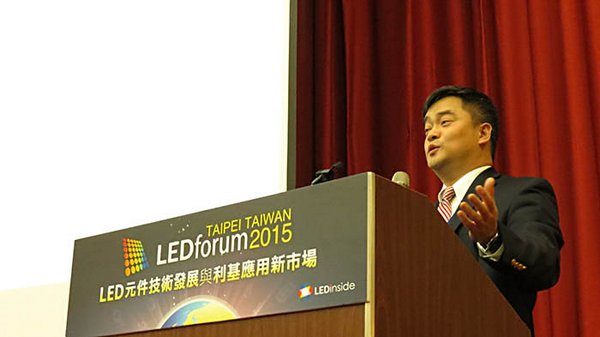Intense price competitions in the LED market over the last few years has caused manufacturers a lot of pain, but it is also the driving force of technology innovation. An emerging trend is the transition of L1 manufacturers migration into L2 manufacturing, projected Sean Zhou, Regional Marketing Director Asia, Lumileds at LEDforum 2015, held at Room 201, National Taiwan University Hospital International Convention Center, Taipei, Taiwan.
 |
|
Sean Zhou, Regional Marketing Director Asia, Lumileds at LEDforum 2015. (All photos courtesy of LEDinside) |
System integration spurring L1 manufacturers’ transformation into L2 manufacturing
Lighting system integration is becoming increasingly important in the industry, due to four major factors. The first is manufacturers need to cut costs on a systematic scale, the need to seek niche markets to avoid the over competitive lighting market, and to meet client demands for products that can be easily installed.
In the lighting industry, Zhou projected an emerging trend will be L1 manufacturers entry into L2 manufacturing. L1 manufacturers are defined by Zhou as package manufacturers that develop low to high power LEDs, CSP LEDs, color LEDs manufacturers, while the L2 camp mostly consists of LEDs on board, and some with secondary optics.
According to Zhou it will be easier for upstream L1 manufacturers to move into L2 market with customized products. Previously, L1 manufacturers held the key to LED chip profile, and determined the chip products Vf, CCT, and other features. Hence the transition will be easier for the manufacturers in the midstream LED sector to make than the other way around, added Zhou.
The advantages of L1 manufacturers’ entry into the L2 manufacturing sector are performance optimization and cost reduction, and reducing wasted lumen output with customized luminaire designs. The difference in luminaire distribution can be seen in the component’s broader distribution. If a LED luminaire emits a minimum of 256 lumens (lm), but the design only requires 250 lm, than 6 lumen output is wasted. However, if a L1 maker takes over the L2 production, the resulting LED product’s wasted lumen output is controlled, and the LED matches the desired L2 application much better, explained Zhou.
Another advantage of L1 manufacturers shift into L2 production is the tailor made products offer greater flexibility. “L1 to L2 integration will become a trend,” said Zhou. The integration will make it more convenient for downstream, create better cost/performance ratio. Compatibility between L1 and L2 products will also become increasingly important to help midstream and upstream LED manufacturers cut production costs.
“L2 build to spec demands have rose in North America, EMEA, ASEAN country but demands are weaker in China,” he added.
Lastly the rise of the Internet of Things (IoT) industry will spur the market demand for smart lighting products that require higher levels of system integration.
“Intel estimates from 2015-2020 there will be 15 billion to 200 billion smart objects emerging on the market,” said Zhou. “On average one person would interact with 26 smart objects.”
 |
|
Sean Zhou, Regional Marketing Director Asia, Lumileds at LEDforum 2015. |
Smart lighting products slow progress plagued by incompatible systems
Despite the budding connective lighting technology, uncertainties plague the new smart lighting market sector. Commenting on the market outlook for smart lighting sector, Zhou pointed out several restrictions: “Can digital lighting become a leading player in the big IoT ecosystem? This is questionable. We might just be a link in the system, or even become marginalized.” None traditional lighting players are emerging in the smart lighting sector, such as mobile phone makers. Schneider, ABB Group or even Google might take over to become the major players in the smart lighting sector in the future, he added.
Compared to none lighting IoT applications, smart lighting has taken off at a much slower rate because of systematic differences. In comparison, to other IoT and electronic devices that have mesh or self-healing properties, lighting has a crucial flaw of lacking resiliency and nearly zero tolerance. “Basically it’s none existent,” said Zhou. “You have to manually replace the broken lighting fixture.”
Lighting products are also less future-proof because they are not as scalable, and cannot be upgraded to a new operating system. Its adaptability and features cannot be easily added to smartphones or a computers through new Apps. It is also slower and less flexible to the introduction of new lighting features. “The most smart lighting products can do is dimming or color tuning,” he explained.
Another restriction is the addition of API to smart lighting systems is completely reliant on technology companies such as CISCO and Microsoft. Adding this to the smart lighting product will enable control of light points, color and dimming including RGBW dimming.
Lack of compatibility and standards for smart lighting system also remains a huge issue in the industry. “Current lighting systems are very old and do not support compatibility,” he added. None smart lighting products on the other hand already have Zigbee and IT protocols.
Moreover, certain adjustments have to be made to the architectural standards to boost the proliferation of smart lighting products. For instance current interactive grid frames and sizes has to do with the length of T8 tube lights. Smart lighting products wiring and sizes will also be partly determined by architectural standards that might need to be amended, said Zhou.
In short, not all things can be down to LED L1 connectivity systems. In the future the smallest control unit will be at L2, said Zhou. “At L1 you cannot add a lot of signals or controls,” he added. Additionally, light’s limited fault tolerance, lack of flexibility and tolerance will make L2 necessary to make scalable lighting products. “In the future a L2 driver could become a single control point for lighting,” added Zhou. By adding an API from Microsoft or Cisco to the smart lighting system, the L2 can become a complete lighting system.
(Author: Judy Lin, Chief Editor, LEDinside)













